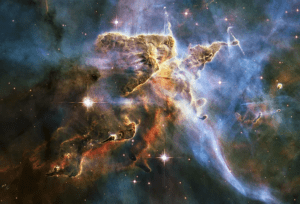The enigmatic realm of supermassive black holes has always captivated astronomers and scientists alike. These cosmic behemoths, residing at the hearts of distant galaxies, possess gravitational forces so strong that not even light can escape their grasp. Recently, a remarkable breakthrough in astrophysics has allowed us to witness an extraordinary phenomenon—the detection of shock waves emanating from the merging of supermassive black holes. This awe-inspiring discovery promises to reshape our understanding of the universe’s most colossal gravitational forces and unveil the secrets concealed within these celestial giants.

- The Journey to the Unknown:
The origins and evolution of supermassive black holes have remained a puzzle for scientists for decades. These monstrous objects are thought to form through various mechanisms, such as the accretion of matter or the merger of smaller black holes. However, the precise processes governing their formation and growth have remained elusive. By harnessing the power of cutting-edge technology and the collaboration of brilliant minds, we have taken a significant stride towards unravelling this cosmic enigma.
- Detecting the Unseen:
A team of astrophysicists working with the Laser Interferometer Space Antenna (LISA) recently made an astonishing breakthrough. LISA, a space-based observatory, is designed to detect gravitational waves—ripples in the fabric of spacetime caused by the motion of massive objects. These waves were first predicted by Albert Einstein over a century ago, but their detection remained a formidable challenge until the groundbreaking observations made by LIGO (Laser Interferometer Gravitational-Wave Observatory) in 2015.
By analyzing the data captured by LISA, scientists have successfully detected shock waves generated by the merger of supermassive black holes. These shock waves, akin to ripples on a pond, emanate from the binary system of black holes as they spiral inward, eventually merging into a single, more massive black hole. This monumental achievement not only confirms the existence of gravitational waves at extreme scales but also provides valuable insights into the processes occurring within the event horizons of these colossal objects.
- Unveiling the Secrets:
The detection of shock waves from merging supermassive black holes opens up a window into the dynamics of these cosmic phenomena. It enables scientists to explore the behavior of matter and energy within the extreme conditions near the event horizons. By studying the properties of these shock waves, scientists can gain unprecedented insights into the mechanisms driving the growth and evolution of supermassive black holes. This newfound understanding may shed light on fundamental questions regarding the role of black holes in galaxy formation and the intricate dance between matter and gravity.
- Implications for Cosmology:
The detection of shock waves from merging supermassive black holes also has profound implications for cosmology—the study of the universe’s origin, evolution, and structure. These observations provide empirical evidence supporting the existence of supermassive black holes and their role as key players in shaping the cosmic landscape. By studying the gravitational waves generated by these mergers, scientists can refine models of galaxy formation and evolution, contributing to our broader understanding of the universe’s intricate web.
- The Future of Black Hole Astrophysics:
The groundbreaking discovery of shock waves from merging supermassive black holes not only represents a remarkable feat of scientific achievement but also opens up exciting avenues for future research. As technology advances and our instruments become more sensitive, we can anticipate further revelations in the field of black hole astrophysics. With future missions like the Event Horizon Telescope poised to image black holes with unprecedented detail, we may soon witness the unveiling of even more profound cosmic secrets.
The shock waves were detected by the Very Large Array (VLA), a radio telescope in New Mexico. The waves were produced as the two black holes spiraled closer and closer together, and they were detected as a series of bright flashes in the radio sky.
The discovery of these shock waves provides new evidence for the existence of supermassive black holes. It also helps to explain how black holes merge, and it could help scientists to better understand the evolution of galaxies.
The detection of shock waves from merging supermassive black holes marks a pivotal moment in our exploration of the cosmos. It showcases the power of human ingenuity, collaboration, and technological advancements in unraveling the mysteries of the universe. With each new revelation, we inch closer to comprehending the enigmatic forces that govern the cosmos. As we embark on this remarkable journey of discovery, the symphony of merging black holes beckons us to listen carefully, as it echoes the harmonious dance of gravity, matter, and spacetime, providing glimpses into the grand tapestry of the cosmos. The discovery of shock waves from merging supermassive black holes is a significant breakthrough in astronomy. It provides new insights into the process of black hole mergers, and it could help scientists to better understand the evolution of galaxies.
